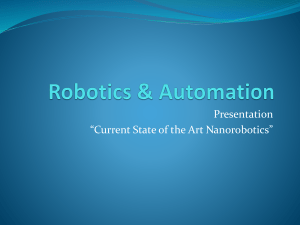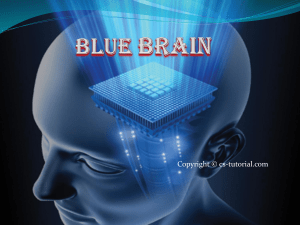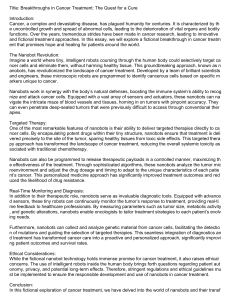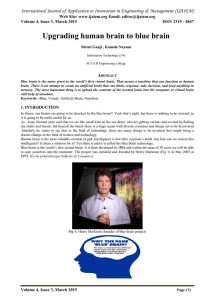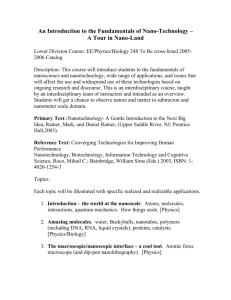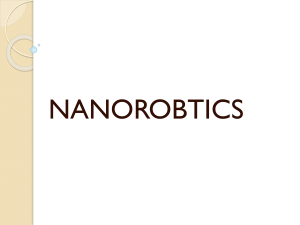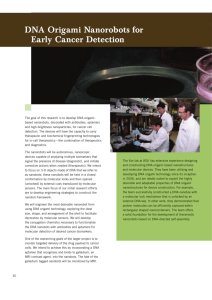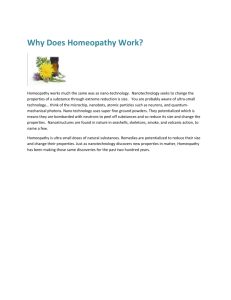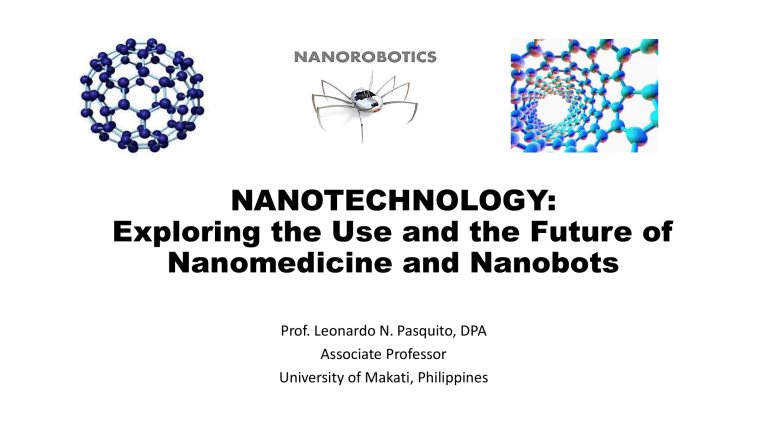
NANOTECHNOLOGY: Exploring the Use and the Future of Nanomedicine and Nanobots Prof. Leonardo N. Pasquito, DPA Associate Professor University of Makati, Philippines FINAL EXAMINATION •December 14 (MTh class) •December 15 (TF Class) •Coverage •Human Genome Project (20 questions) •Nanotechnology (20 questions) •10 points (bonus) Scope of this Presentation • Exploring Medical Nanobots • Medical nanobots can serve as miniature surgeons which can be used to repair damaged cells or entirely replace intracellular structures. • Can replicate themselves to correct a genetic deficiency or replace DNA molecule to eradicate disease. • Exploring Military Nanobots • Weaponized nanobots can be programmed to perform a variety of surveillance and lethal functions. • If self replicating, autonomous and would kill indiscriminately. What is nanotechnology? ▪ Remember U-nano (small people) ▪ The prefix ‘nano’ is referred to a Greek prefix meaning ‘dwarf’ or something very small and depicts one thousand millionth of a meter (1 x 10−9 m). ▪ Nanoscience vs Nanotechnology ▪ Nanoscience is the study of structures and molecules on the scales of nanometers ranging between 1 and 100 nm. ▪ Nanotechnology refers to the branch of science and engineering devoted to designing, producing, and using structures, devices, and systems by manipulating atoms and molecules at nanoscale, i.e. having one or more dimensions of the order of 100 nanometers (100 millionth of a millimeter) or less. Types of Nanodevices used as carriers of proteins, peptides and other therapeutic molecules Dendrimers are highly branched, synthetic molecules. Their precisely controlled size, shape, and surface functionality make them valuable in drug delivery systems, as catalysts, in nanotechnology for electronics, and as imaging agents in medical diagnostics. Micelles are spherical amphiphilic structures that have a hydrophobic core and a hydrophilic shell. The hydrophilic shell makes the micelle water soluble that allows for intravenous delivery while the hydrophobic core carries a payload of drug for therapy. Magnetic nanoparticles refer to tiny particles, often measuring less than 100 nanometers in diameter, made from magnetic materials like iron, cobalt, or nickel. These nanoparticles possess unique magnetic properties due to their size, enabling various applications in medicine, electronics, environmental remediation Liposomes are spherical vesicles of a bilayer of phospholipids. These lipids are amphiphilic in nature because they have hydrophilic and hydrophobic part. Liposomes are useful in drug delivery system because they can encapsulate both hydrophilic and hydrophobic drugs. Nanopores are tiny holes or openings on the nanometer scale, used in DNA sequencing, where the movement of DNA strands through these nanopores can be monitored and analyzed, allowing for the determination of the DNA sequence. Nanopores can also be used in drug delivery because they allow certain molecules or ions to pass through based on their size and properties. A carbon nanotube is a carbon allotrope that resembles a tube of carbon atoms. Carbon nanotubes are extremely robust and difficult to break, but they are still light. Because of their exceptional mechanical, electrical, and thermal properties, carbon nanotubes are one of the most investigated nanomaterials. Quantum dots are tiny semiconductor particles usually between 2 to 10 nanometers in size, making them incredibly small. They have the ability to emit light at different wavelengths based on their size. This property makes them valuable in biological imaging to track cellular processes. History of Nanotechnology • The American physicist and Nobel Prize laureate Richard Feynman introduce the concept of nanotechnology in 1959. During the annual meeting of the American Physical Society, Feynman presented a lecture entitled “There’s Plenty of Room at the Bottom” at the California Institute of Technology (Caltech). • In this lecture, Feynman made the hypothesis “Why can’t we write the entire 24 volumes of the Encyclopedia Britannica on the head of a pin?”, and described a vision of using machines to construct smaller machines and down to the molecular level. Because of these new ideas, he is considered the father of modern nanotechnology. • Norio Taniguchi, a Japanese scientist was the first to use and define the term “nanotechnology” in 1974 as: “nanotechnology mainly consists of the processing of separation, consolidation, and deformation of materials by one atom or one molecule” . Timeline showing the milestones in the history of nanoscience and nanotechnology development. The Nanobots • In 1959, the theoretical physicist Richard Feynman predicted that one day it would be possible to build tiny machines of only a few thousand atoms. Feynman is the winner of the Nobel Prize in Physics in 1965. • Later in the 1987 novel, “Engines of Creation,” Eric Drexler describes that nanobots are: • capable of destroying cancer cells • collecting free radicals • or repairing damage to cell tissues. • Genetics, biochemistry, physics, engineering, and materials are the pillars for the creation and development of nanotechnology. What is a Nanobot? ▪ Nanobots are nanoscopic robots or what is the same as a robot about the size of an atom ▪ Nanorobots are so small that they actually interact on the same level as bacteria and viruses do, and so they are capable of building with the very particles of our bodies: atoms and molecules. ▪ The ideal nanobot has not yet been fully realized, but when this microscopic robot makes its inevitable debut it will be hailed as a lifesaver by the world of medicine. Composition of Nanobots • Scientists report the exterior of a nanorobot will likely be constructed of carbon atoms in a diamondoid structure because of its inert properties and strength. • Super-smooth surfaces will lessen the likelihood of triggering the body's immune system, allowing the nanorobots to go about their business unimpeded. • Glucose or natural body sugars and oxygen might be a source for propulsion, and the nanorobot will have other biochemical or molecular parts depending on its task. Approaches of Developing Nanomaterials • After Feynman had discovered this new field of research catching the interest of many scientists, two approaches have been developed describing the different possibilities for the synthesis of nanostructures. 1. The “top-down” approach This involves the breaking down of large pieces of material to generate the required nanostructures from them. This is from big materials to nanoscale. 2. The “bottom-up” approach This implies assembling single atoms and molecules into larger nanostructures. This is from individual atoms to nanoscale. A comparison of sizes of nanomaterial Uses of Nanotechnology • Fight some disease. Nanobots can travel inside the human body to fight some diseases or repair organs • Detecting pollution and for cleaning the environment (cleaning up oil spill) • Cure of diseases, and in particular, cancer • Nanobots for military espionage or as a spy. Uses of Nanotechnology Exploring Nanomedicine and Medical Nanobots Nanotechnology In Medicine • Detect cancer cells and release drugs on them. • Researchers from the Israel Institute of Technology (Technion) and the Federal Polytechnic School of Zurich, would have created nanobots made of polymers and magnetic nanowires, capable of being introduced into the human bloodstream and remote control inside to detect cancer cells and release drugs on them. • Instead of performing procedures from outside the body, nanobots will be miniaturized for introduction into the body through the vascular system or at the end of catheters into various vessels and other cavities in the human body. • On-site surgical Operation • A surgical nanobot, programmed by a human surgeon, could act as an autonomous on-site surgeon inside the human body. Various functions such as searching for pathology, diagnosis, and removal or correction of the lesion by nanomanipulation can be performed and coordinated by an on-board computer. Uses of Nanotechnology • Repair tissues • The most important future role for nanobots will be to carry out tricky repairs that at present require major surgery; for example, clearing plaque from the walls of blood vessels, or renewing calcified heart valves. The body has wonderful repair mechanisms of its own but for generally presently unknown reasons certain actions appear to be impossible. • Nanomedicine could make use of these nanorobots introduced into the body, to repair or detect damages and infections. • Drug delivery System • They can be used very effectively for drug delivery. Normally, drugs work through the entire body before they reach the disease-affected area. Using nanotechnology, the drug can be targeted to a precise location which would make the drug much more effective and reduce the chances of possible side effects. • Monitoring • Nanobots can be used to monitor the sugar level in the blood. Special sensor nanobots can be inserted into the blood under the skin where microchips, coated with human molecules and designed to emit an electrical impulse signal, monitor the sugar level in the blood. Uses of Nanotech in Medicine Theranostics refers to a field in medicine focused on developing and combining diagnostic tests with specific targeted therapies. The goal is to personalize treatment by identifying suitable patients for particular therapies while monitoring the response to treatment. Essentially, it combines diagnostics that help identify the most effective treatment with therapies tailored to the individual's needs, leading to more precise and efficient healthcare. Future of Nanotechnology in Medicine • Using nanobots with camera will allow doctors to discontinue the use of endoscopy. • Endoscopy involves inserting a thin, flexible tube with a camera down the throat to examine the esophagus, stomach, and the beginning of the small intestine. Doctors often perform this to diagnose conditions like acid reflux, ulcers, or even cancers. It is commonly used if someone has persistent heartburn, difficulty swallowing, or unexplained weight loss. Carbon nanotubes Carbon Bucky Ball Carbon Nanotube Types and Structures of Carbon Nanotechnology (CNT) Current Use of Carbon-Based Materials Immunogenicity is defined as the ability of cells or tissues to provoke an immune response and is generally considered to be an undesirable physiological response. Nanoparticles as carriers of proteins, peptides and other therapeutic molecules Structure of Nanotubes New Carbon Nanotube-Based Breast Cancer Drug Direct drug delivery with carbon nanotube porins Nanowerk How Carbon Nano Tube (CNT) deliver drugs How Carbon Nanotubes (CNT) get Inside the Cell Nanobots with cameras Nanobots equipped with cameras have shown remarkable potential in various fields, particularly in medicine and technology. These tiny devices, often smaller than a grain of sand, incorporate miniature cameras that enable visualization at a microscopic level. In medicine, nanobots with cameras hold promise for non-invasive diagnostic procedures and targeted drug delivery. They can navigate through the body to identify health issues and transmit images or data to external devices for analysis. These nanobots are being explored for applications such as surveillance, inspection of small spaces, and monitoring environments that are difficult for conventional cameras to access. Cancer-killing nanobots The nanorobots improve treatment efficiency by performing advanced biomedical therapies using minimally invasive operations. Chemotherapy's harsh side effects and untargeted drug distribution necessitate new cancer treatment trials. The nanorobots are currently designed to recognize 12 different types of cancer cells. Nanobots for checking blood chemistry Nanobots are being researched for various medical applications, including monitoring blood chemistry. These tiny devices, smaller than a cell, could potentially travel through the bloodstream, detecting and analyzing specific biomarkers or substances. They might offer real-time data on blood sugar levels, oxygenation, or even detect markers for diseases like cancer. Types of NanoBots • The two basic types of nanobots are assemblers and self-replicators 1. Assemblers • Assemblers are nanobots in the form of single cells that may be able to decipher molecules or atoms of different types and controlled by specific programs. By their use, they are also familiar as molecular assemblers. As a reference to a structure inside each cell of every living being called ribosome that is the natural “assemblers.” 2. Self-replicants • Self-replicants are mostly nanobots capable of duplicating (self-replicating) themselves at high speed. This type of duplication helps to build large-scale applications or deploy nanobots for large-scale tasks. • In the military investigation, they can use self-replicators as an armor of the military body. It is capable of self-repair in case of damage. Sharief, K. (2020).What is Nanobots? – Definition, Uses, Types, History And More. https://www.computertechreviews.com/definition/nanobots/ Types of nanobots 3. Nanoswimmers • ETH Zurich and Technion researchers have developed an elastic “nanoswimmer” polypyrrole (Ppy) nanowire about 15 micrometers (millionths of a meter) long and 200 nanometers thick. • They can move through biological fluid environments at almost 15 micrometers per second. • The nanoswimmers could be functionalized to deliver drugs and magnetically controlled to swim through the bloodstream to target cancer cells, for example. Source: Different Types of Nanorobots and Applications – Advanced Materials 2019 https://advancedmaterials2018.wordpress.com/2018/10/08/different-types-of-nanorobotsand-applications-advanced-materials-2019/ 4. Nanomachines • 3D-motion nanomachines from DNA • Mechanical engineers at Ohio State University have designed and constructed complex nanoscale mechanical parts using ‘DNA origami’ — proving that the same basic design principles that apply to typical full-size machine parts can now also be applied to DNA — and can produce complex, controllable components for future nanorobots. Programmable Nanobots Their programmability allows for precise control over their actions, often through external stimuli like light, magnetic fields, or specific chemical signals. Researchers envision applications in medicine, such as delivering medication to specific cells or tissues, as well as in engineering for tasks like assembling minuscule components. NANOBOTS THAT CAN REPAIR DNA Nanotechnology has made remarkable strides in the realm of DNA repair. Nanobots are being developed to precisely target damaged DNA strands and initiate repair processes within cells. These nanobots are often designed to carry specific payloads, such as enzymes or molecules, that aid in repairing damaged DNA. For instance, they might carry out tasks like excising mutated sections of DNA and replacing them with correct sequences or facilitating repair mechanisms within the cell. Nanotechnology Helps Revolutionize Medicine Types of Nanobots being Developed for Use in Healthcare • Nanotechnology researchers are developing robots about the size of the cells in our bodies that have a propulsion system, sensors, manipulators, and even an onboard computer that can perform tasks on nanoscale objects. Boysen, E.; Muir N.; Dudley, D.; Peterson, D. (n.d.). Types of Nanorobots being Developed for Use in Healthcare. https://www.dummies.com/education/science/nanotechnology/types-of-nanorobots-being-developed-for-usein-healthcare Types of Nanobots being Developed for Use in Healthcare 1. Microbivore nanobots • These nanorobots would function similarly to the white blood cells in our bodies, but they are designed to be much faster at destroying bacteria. • This type of nanorobots should be able to eliminate bacterial infections in a patient within minutes, as opposed to the weeks required for antibiotics to take effect. • Microbivore nanorobots are designed so that antibodies attach to the particular bacteria the robot is seeking. • After bacteria attaches to an antibody, an arm grabs the bacteria and moves it to the inside of the nanorobot, where it’s destroyed. Bacteria is then discharged into the bloodstream as harmless fragments. Types of Nanobots being Developed for Use in Healthcare 2. Respirocyte nanobots • These nanorobots would function in a similar way to the red blood cells in our bodies; however, they are designed to carry much more oxygen than natural red blood cells. • This design could be very useful for patients suffering from anemia. • These respirocyte nanorobots would contain a tank in which oxygen is held at a high pressure, sensors to determine the concentration of oxygen in the bloodstream, and a valve that releases oxygen when sensors determine that additional oxygen is needed. Types of Nanobots being Developed for Use in Healthcare 3. Clottocyte nanorobots • These robots function similarly to the platelets in our blood. • Platelets stick together in a wound to form a clot, stopping blood flow. Depending on the size of the wound, significant blood loss can occur before a clot is formed. • A system of clottocyte nanorobots would store fibers until they encounter a wound. At that point, the nanorobots would disperse their fibers, which would then come together to create a clot in a fraction of the time that platelets do. Types of Nanobots being Developed for Use in Healthcare 4. Cellular repair nanobots • These little guys could be built to perform surgical procedures more precisely. • By working at the cellular level, such nanorobots could prevent much of the damage caused by the comparatively clumsy scalpel. Types of Nanobots being Developed for Use in Healthcare 5. Ant-like nanoengine • Otherwise known as actuating nanotransducers (ANT) • University of Cambridge researchers have developed a tiny engine capable of a force per unit-weight nearly 100 times higher than any motor or muscle. • The new nano-engines could lead to nanorobots small enough to enter living cells to fight disease, the researchers say. • Professor Jeremy Baumberg from the Cavendish Laboratory, who led the research, has named the devices ‘actuating nanotransducers’ (ANTs). • ‘Like real ants, they produce large forces for their weight. Types of Nanobots being Developed for Use in Healthcare 6. Sperm-inspired nanobots • “A team of researchers at the University of Twente (Netherlands) and German University in Cairo (Egypt) has developed sperm-inspired microrobots, which can be controlled by oscillating weak magnetic fields.” • They will be used in complex micromanipulation and targeted therapy tasks. Types of Nanobots being Developed for Use in Healthcare 7. Bacteria-powered robots • Drexel University engineers have developed a method for using electric fields to help microscopic bacteria-powered robots detect obstacles in their environment and navigate around them. • Uses include delivering medication, manipulating stem cells to direct their growth, or building a microstructure, for example. Types of Nanobots being Developed for Use in Healthcare 8. Nanorockets • Several groups of researchers have recently constructed a high-speed, remote-controlled nanoscale version of a rocket by combining nanoparticles with biological molecule • The researchers hope to develop the rocket so it can be used in any environment; for example, to deliver drugs to a target area of the body. Nano Designs Parts of Nanobot Parts of Nanobot Nanobot Insects Spider Nanobot Nanobots at Work Future of Nanobots • Nanomedicine • Imagine that you go to the doctor for treatment for persistent fever. Instead of giving you a pill or an injection, the doctor sends you to a specialized medical team that implants a small robot into your bloodstream. The robot detects the cause of the fever. It travels to the appropriate system and provides a dose of the medication directly to the infected area. • The biggest problem right now is to provide the nanobots with autonomous movement and a navigation system. Future of Nanobots • Biohybrid nanobots could eventually remove blood clots from the brain without surgery, deliver drugs directly to organs, or assist with fertilization. • Nanomedicine is particularly focused on localized therapies to combat cancer, and plenty of progress has been made. • Nanotechnology could also enable objects to harvest energy from their environment. New nano-materials and concepts are currently being developed that show potential for producing energy from movement, light, variations in temperature, glucose and other sources with high conversion efficiency. Future of Nanobots • Scientists hope to use nanobots in medicine to • kill cancer cells • deliver drugs to target tissues • improve vaccines. • Nanobots can be used in research for • DNA probes • cell imaging materials • cell-specific delivery vehicles • It is also predicted that nanorobots could slow or even reverse the aging process, and life expectancy of human beings could increase significantly. • Nanotechnology might help us make electrical lines, solar cells, and biofuels more efficient, and make nuclear reactors safer. • Nanobots may give physicians the most potent tools imaginable to conquer human disease, ill-health, and aging. Nanotechnology in the Philippines Potential Military Applications 1. To improve medical and casualty care for soldiers 2. To produce lightweight, strong and multi-functional materials for use in clothing, both for protection 3. To provide enhanced connectivity. 4. nanometer bomb which in the dimension of macro-nanometer and is designed on the base of nanometer carbon tube singular light quantum performance and near-infrared laser radiation, Issues and Concerns of Nanobots • Several countries are developing nanoweapons that could unleash attacks using mini-nuclear bombs and insect-like lethal robots. • The advancement of nanotechnology in the coming years will make it a bigger threat to humanity than conventional nuclear weapons, according to an expert. The U.S., Russia and China are believed to be investing billions on nanoweapons research. • “Nanobots are the real concern about wiping out humanity because they can be weapons of mass destruction”, said Louis Del Monte, a Minnesota-based physicist and futurist. Issues and Concerns of Nanobots • Nanodrone in the future could fly into a room and drop a poison onto something, such as food, to target a particular individual. • Frightening details about military nanotechnologies were outlined in a 2010 report from the Pentagon’s Defense Threat Reduction Agency, including how “transgenic insects could be developed to produce and deliver protein-based biological warfare agents, and be used offensively against targets in a foreign country.” • It also forecast “microexplosives” along with “nanobots serving as bioweapons delivery systems or as micro-weapons themselves, and inhalable micro-particles to cripple personnel.” Issues and Concerns of Nanobots • In the case of nanoscale robots, they can be the size of a mosquito or smaller and programmed to use toxins to kill or immobilize people; what’s more, these autonomous bots ultimately could become selfreplicating. • Last month’s targeted assassination of Kim Jong-nam, the half-brother of North Korea’s ruler, was a stark reminder that toxins are available from a variety of sources and can be unleashed in public locations. It is also been alleged by Russia’s Pravda paper that nanoweapons were used by the U.S. against foreign leaders. • A Cambridge University conference on global catastrophic risk found a 5 percent risk of nanotech weapons causing human extinction before the year 2100. Issues and Concerns of Nanobots • Nanotechnology opens up the possibility to manufacture mini-nuke components so small that they are difficult to screen and detect. Furthermore, the weapon (capable of an explosion equivalent to about 100 tons of TNT) could be compact enough to fit into a pocket or purse and weigh about 5 pounds and destroy large buildings or be combined to do greater damage to an area. • There could be potentially millions of these deadly nanobots on the loose killing people indiscriminately. Issues and Concerns of Nanobots • Potential disadvantages include economic disruption and possible threats to security, privacy, health and the environment. • Potential dangers to humans and the environment. • Loss of manufacturing and agricultural jobs. • Economic market crashes related to a potential lower value of oil due to more efficient energy sources and gold or diamonds, materials that can be reproduced with molecular manipulation. • Environment will be increasingly prone to suffer pollution from nanomaterials in consumer products such as sunscreens, detergents, and cosmetics, as well from accidental releases during production, transportation, and disposal operations. • Nanoparticles are likely to be dangerous for three main reasons: • Nanoparticles may damage the lungs. • Nanoparticles can get into the body through the skin, lungs and digestive system. This may help create 'free radicals' which can cause cell damage and damage to the DNA. • Tissue studies indicate that nanoparticles could damage DNA and lead to cancer, according to research presented at the 2007 Annual Meeting of the American Association for Cancer Research. • A number of manufactured nanomaterials have however been associated with health hazards. Research by the scientific committee on emerging and newly identified risks (SCENIHR) has indicated that some nanomaterials can be taken up in the lungs causing inflammation and tissue damage, fibrosis and tumour generation. • Hazards and risks of nanoparticles include increased production of ROS, DNA damage, genotoxic effects, damages to organs and tissues in humans, effects on growth and yield of crop plants and negative impacts on beneficial bacteria in the environment. • Self-replicating "nanobots" could escape from laboratories and reduce all life on earth. Bio-antifouling refers to methods or substances that prevent the accumulation of unwanted biological organisms. Exploring Military Nanotechnology Military Nanobots The main aims of military research into nanotechnology are to improve medical and casualty care for soldiers, and to produce lightweight, strong and multi-functional materials for use in clothing, both for protection and to provide enhanced connectivity. • The U.S. Military is making plans to inject people’s brains with artificially intelligent nanobots that will give them awesome, Wolverine-like powers to heal themselves. • DARPA, the American government’s controversial, ultra high-tech military gadget and research lab, is developing wireless, “ultraminiaturized” and injectable electronic devices that could eventually get on people’s nerves. • In the longer term, it seems likely that most military technology will be dependent on nanomaterials. Some of the more speculative applications of nanotechnology in this area include: • • • • • • Nano-machines to mimic human muscle action in an exoskeleton Stealth coatings Self-healing (self-repair) material Smart skin materials Adaptive camouflage Adaptive structures References • Mehta, M.; Subramani, K. (2012). Nanodiagnostics in Microbiology and Dentistry. Science Direct. From https://www.sciencedirect.com/topics/engineering/nanobots • Shandrow, K. (2014, October 21). The U.S. Military Wants to Inject People's Brains With Painkilling Nanobots That Could Replace Medicine. https://www.entrepreneur.com/article/238677 • Daniels, J. (2017, Mar 17). Mini-nukes and mosquito-like robot weapons being primed for future warfare. https://www.cnbc.com/2017/03/17/mini-nukes-andinspect-bot-weapons-being-primed-for-future-warfare.html
